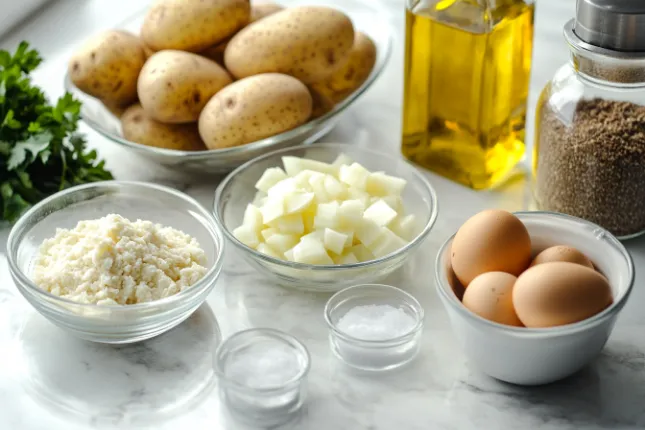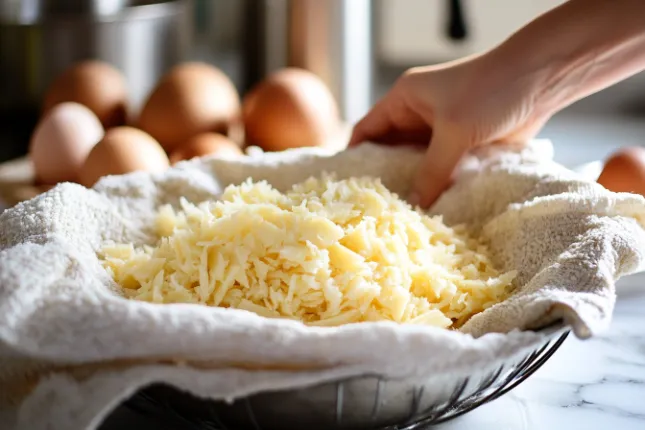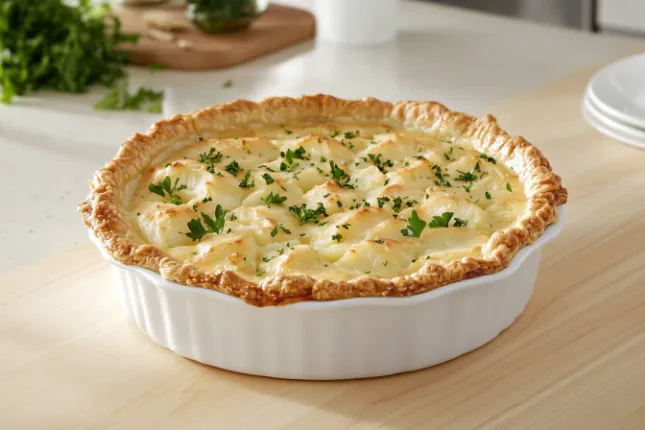Introduction
Let’s talk about Passover Potato Pie—a dish that brings comfort, tradition, and a whole lot of flavor to your table. It’s not just another side dish; it’s a recipe steeped in history and cultural significance, perfect for adding a touch of homemade warmth to your Seder meal.
This dish combines layers of tender potatoes with a creamy, savory filling, making it a standout for Passover celebrations. Moreover, it’s incredibly versatile—you can tweak the recipe to match your preferences or dietary needs without breaking a sweat. Furthermore, it’s a lifesaver for those big holiday meals when you need something hearty that everyone will love.
But here’s the kicker: Passover Potato Pie isn’t just delicious; it’s easy to make. Using basic ingredients like potatoes, eggs, and matzo meal, you can whip up a dish that’s both budget-friendly and crowd-pleasing. Honestly, it’s like a warm hug in food form.
(For a similar recipe with a unique twist, check out this Passover Potato Kugel Recipe.)
Part 1: History and Origin
Every recipe has a story, and Passover Potato Pie is no exception. This dish finds its roots in the Ashkenazi Jewish culinary tradition, where potatoes became a staple for Passover meals. Why potatoes? They’re simple, filling, and kosher for Passover—making them a practical and symbolic choice.
During Passover, leavened foods are forbidden, so Jewish cooks relied on humble ingredients like potatoes to create satisfying meals. Over time, variations of potato-based dishes, such as kugel and pies, emerged as festive favorites. Imagine families gathered around the table, sharing stories while enjoying hearty slices of this comforting dish.
Moreover, the addition of matzo meal and eggs helped create structure, giving the pie its signature texture. With a golden crust on top and creamy layers within, Passover Potato Pie embodies the balance of simplicity and elegance that defines so much of Jewish cooking.
Interestingly, potatoes weren’t part of the Passover diet until they became widely available in Europe in the late 18th century. Their introduction revolutionized holiday cooking, leading to beloved recipes like this one. Today, we celebrate this evolution by adding our own modern touches, such as fresh herbs or even cheese (for non-meat meals).
(Curious about the role of potatoes during Passover? Learn more here.)
What’s Next?
In Part 2, we’ll dive into the ingredients you’ll need to make Passover Potato Pie. Don’t worry—everything is simple and easy to find, with room for substitutions to suit your preferences. Stay tuned!
Part 3: Step-by-Step Recipe Guide for Passover Potato Pie
Making the perfect Passover Potato Pie is easier than you think! Follow these detailed steps, and you’ll have a dish that’s golden, creamy, and utterly irresistible. Whether you’re a seasoned cook or a newbie in the kitchen, this guide has you covered.
Step 1: Gather Your Ingredients
First things first, set up your workspace and gather all your ingredients. Trust me, having everything ready makes cooking so much smoother. Here’s what you’ll need:
| Ingredient | Quantity | Substitutions/Notes |
|---|---|---|
| Potatoes (russet or Yukon gold) | 4 large | Sweet potatoes for a sweeter twist |
| Eggs | 3 | Use flax eggs for a vegan alternative |
| Matzo meal | 1/2 cup | Substitute with almond flour for gluten-free |
| Onions (finely chopped) | 1 large | Shallots for a milder flavor |
| Oil (vegetable or olive) | 3 tbsp | Butter or ghee for richer taste (non-meat meals) |
| Salt and pepper | To taste | Add garlic powder or paprika for extra flavor |
(For more on Passover-friendly ingredients, check out this Passover Potato Kugel Recipe.)

Step 2: Prepare the Potatoes
Next, peel and wash your potatoes. Grate them using a box grater or food processor, depending on what you have handy. After grating, place the potatoes in a clean kitchen towel and squeeze out as much liquid as possible. This step is crucial—it prevents the pie from becoming soggy.
Pro Tip: If you’re short on time, grate the potatoes directly into a bowl of cold water to keep them from browning. Then drain and squeeze.
Step 3: Mix the Ingredients
Now, grab a large mixing bowl. Add the grated potatoes, finely chopped onions, matzo meal, eggs, salt, and pepper. Mix everything thoroughly until well combined.
Helpful Tip: If the mixture feels too dry, add a tablespoon of water or broth. If it’s too wet, sprinkle in a bit more matzo meal.
Step 4: Prepare the Baking Dish
Then, preheat your oven to 375°F (190°C). Lightly grease a baking dish with oil or line it with parchment paper for easy cleanup. Spread the potato mixture evenly in the dish, pressing it down gently to create a compact layer.
Optional: Drizzle a little oil on top for a golden, crispy crust.

Step 5: Bake the Pie
Place the dish in the preheated oven and bake for 45–50 minutes. Check the pie around the 30-minute mark to ensure it’s cooking evenly. The top should be golden brown, and the potatoes should be tender when pierced with a fork.
Pro Tip: If the top starts browning too quickly, cover it with foil and continue baking.
Step 6: Let It Cool and Serve
Finally, remove the pie from the oven and let it cool for at least 10 minutes. This helps it set and makes slicing easier. Serve warm as a side dish or the main event—it’s perfect either way!
Serving Suggestion: Garnish with fresh parsley or dill for a pop of color and flavor.
Troubleshooting and Tips
- Too Soggy? Ensure you’ve thoroughly drained the grated potatoes. Soggy potatoes can ruin the texture.
- Not Crispy Enough? Drizzle more oil on the top before baking.
- Running Out of Time? Bake the pie in muffin tins for individual portions that cook faster.
This recipe for Passover Potato Pie is not only straightforward but also allows for creativity with spices and substitutions. Don’t be afraid to experiment! Stay tuned for Part 4, where we’ll explore modern twists and variations to make this dish even more exciting.
Part 4: Tips and Troubleshooting for Perfect Passover Potato Pie
Making the perfect Passover Potato Pie can sometimes be tricky, but with a few handy tips, you’ll nail it every time. Let’s tackle some common challenges and solutions to ensure your dish is a hit.
Common Challenges and Solutions
Soggy Pie
One of the most common issues is a soggy pie. This happens when the potatoes aren’t properly drained.
- Solution: Always squeeze out as much water as possible from the grated potatoes using a kitchen towel. However, if the mixture still seems too wet, add a little extra matzo meal to absorb the moisture.
Uneven Baking
Sometimes, the top browns too quickly while the center remains undercooked.
- Solution: Cover the dish with foil if you notice uneven browning. On the other hand, if the edges are browning too fast, lower the oven temperature slightly.
Dry or Crumbly Pie
If your pie turns out too dry, the balance of wet ingredients might be off.
- Solution: Add a splash of broth or a little extra egg to moisten the mixture. Additionally, be sure not to overbake—it can dry out the pie.
Pro Tips for Success
- Preheat the Oven: Always preheat your oven to ensure even cooking.
- Use Fresh Ingredients: Fresh potatoes and onions will give you the best flavor and texture.
- Customize the Seasoning: While salt and pepper are classic, consider adding garlic powder or paprika for a unique twist.
Mastering these tips will make your Passover Potato Pie not only delicious but also foolproof!
Part 5: Serving and Garnishing Your Passover Potato Pie
Presentation matters, especially during Passover meals. Whether you’re serving this dish as a side or centerpiece, here are some ideas to make it stand out.
Creative Serving Suggestions
- Family-Style: Serve the pie in the baking dish for a rustic, homey vibe. Garnish with fresh parsley or dill for a splash of color.
- Individual Portions: Bake the potato mixture in muffin tins for single-serving pies. It’s an easy way to serve guests without the need for slicing.
- Layered Elegance: Use a round baking dish and cut the pie into wedges, like a cake, for a more formal presentation.
Perfect Pairings
Pair your Passover Potato Pie with these classic sides:
- Matzo Ball Soup: The light broth complements the richness of the pie.
- Roasted Vegetables: A medley of carrots, zucchini, and asparagus adds color and flavor to the meal.
- Fresh Salad: A crisp green salad with vinaigrette balances the dish’s creamy texture.
(If you love potatoes, why not try another variation? Our Scalloped Potatoes with Cheese Powder recipe brings a creamy and cheesy twist to the table—perfect as a holiday side dish.)
With these serving ideas and garnishes, your Passover Potato Pie will look as good as it tastes. Ready to try some creative variations? Stay tuned for Part 6!
Part 6: Healthier Alternatives and Dietary Considerations
Ingredient Swaps for Dietary Needs
Creating a healthier version of Passover Potato Pie or adapting it for dietary restrictions is simple with a few thoughtful swaps. Here are some ideas to keep it flavorful while catering to specific needs:
Gluten-Free Version
- Substitute matzo meal with almond flour or gluten-free matzo meal. Almond flour adds a nutty flavor that complements the potatoes.
Vegan Option
- Replace eggs with flax eggs. To make a flax egg, mix 1 tablespoon of ground flaxseed with 3 tablespoons of water and let it sit for 5 minutes. Additionally, use olive oil or a neutral oil instead of butter for greasing the dish.
Lower-Calorie Alternative
- Use sweet potatoes instead of regular potatoes. Sweet potatoes are naturally sweeter, lower in calories, and packed with vitamins.
- Reduce the oil by half and replace it with vegetable broth for a lighter texture.
Protein-Packed Twist
- Add cooked lentils or chickpeas to the potato mixture for a boost of protein and texture.
Creative Variations
For example, you can mix in fresh herbs like parsley, dill, or chives to enhance the flavor. Additionally, sprinkle the top with za’atar or paprika for a unique twist that pairs perfectly with the classic dish.
Part 7: Storing and Reheating Passover Potato Pie
To keep your Passover Potato Pie fresh and delicious, proper storage and reheating are key. Here are practical tips:
Storing Leftovers
- Room Temperature: Allow the pie to cool completely before covering it with plastic wrap or foil. Store at room temperature for up to 2 hours.
- Refrigeration: Transfer the pie to an airtight container and refrigerate for up to 5 days.
- Freezing: Wrap individual slices in plastic wrap, then place them in a freezer-safe bag. Frozen portions can last up to 3 months.
Reheating Tips
- Oven: Preheat the oven to 350°F, cover the pie with foil, and bake for 15–20 minutes. This method maintains its texture and crispiness.
- Microwave: For quicker reheating, microwave individual portions on a microwave-safe plate for 1–2 minutes. However, this may soften the crust.
- Air Fryer: Reheat slices in the air fryer at 325°F for 5–7 minutes for a crispy top and warm interior.
(Need more ideas for Passover-friendly meals? Check out our recipe for Traditional Potato Kugel.)
By following these tips, your Passover Potato Pie will stay fresh and flavorful, whether you’re serving it immediately or enjoying leftovers later. Ready for the FAQs? Let’s dive in next!
Part 8: Frequently Asked Questions (FAQs)
Can Jews Eat Potatoes During Passover?
Yes, potatoes are kosher for Passover and are widely used during the holiday. For example, they are a key ingredient in recipes like Passover Potato Pie and potato kugel. Potatoes are especially common because they’re filling, versatile, and naturally unleavened, aligning perfectly with Passover dietary laws.
Can You Eat Kugel on Passover?
Yes, you can enjoy kugel on Passover, but it must be prepared with kosher-for-Passover ingredients. Instead of using traditional noodles or breadcrumbs, many recipes substitute matzo meal or potatoes. Passover Potato Pie is a close cousin to potato kugel, offering a similar comforting flavor in a pie form.
Are Potato Pancakes Kosher for Passover?
Potato pancakes, or latkes, can be kosher for Passover if made with Passover-friendly ingredients. For example, use potato starch or matzo meal instead of flour. This makes them an excellent side dish to pair with Passover Potato Pie.
Is Potato Starch OK for Passover?
Absolutely! Potato starch is a common substitute for flour during Passover because it’s naturally unleavened and works well in baking and thickening recipes. Consequently, it’s often used in desserts, sauces, and savory dishes, making it a pantry essential for the holiday.
(For more Passover recipe ideas, check out our guide to Traditional Passover Recipes.)
Part 9: Conclusion
And there you have it—everything you need to know to make a perfect Passover Potato Pie. From its cultural roots to helpful tips for preparation, serving, and storage, this dish is as versatile as it is delicious.
Passover is a time for family, tradition, and amazing food. A dish like Passover Potato Pie embodies all of that, bringing comfort and flavor to your holiday table. Whether you’re a seasoned cook or trying your hand at this recipe for the first time, it’s sure to become a cherished addition to your Passover celebrations.
Why not give it a try? Share your thoughts, experiment with the variations, and enjoy the process of making this timeless dish. For more Passover recipes, don’t miss our take on Passover Potato Kugel—another classic you’ll love!
Happy cooking, and chag sameach! 🍴




